|

User's Guide
|
|
Printer Software
Setting Up Your Printer on a Network
 Sharing the printer
Sharing the printer
 Setting up your printer as a shared printer
Setting up your printer as a shared printer
 Setting for the clients
Setting for the clients
 Installing the printer driver from the CD-ROM
Installing the printer driver from the CD-ROM
Sharing the printer
This section describes how to share the printer on a standard Windows network.
The computers on a network can share a printer that is directly connected to one of them. The computer that is directly connected to the printer is the printer server, and the other computers are the clients which need permission to share the printer with the printer server. The clients share the printer via the printer server.
According to the versions of Windows OS and your access rights on the network, perform the appropriate settings of the printer server and clients.
Setting the printer server
Setting the clients
 |
Note:
|
 | -
When sharing the printer, be sure to set EPSON Status Monitor 3 so that the shared printer can be monitored on the printer server. See Setting up EPSON Status Monitor 3.
|
|
 | -
When you are Windows shared printer user in a Windows Me or 98 environment, on the server, double-click the Network icon in Control panel and make sure that the "File and printer sharing for Microsoft Networks" component is installed. Then, on the server and clients, make sure that the "IPX/SPX-compatible Protocol" or the "TCP/IP Protocol" is installed.
|
|
 | -
When connecting to a Windows XP shared printer, error and warning notifications do not appear during printing. Installing Windows XP Service Pack 1 or later will solve this problem.
|
|
 | -
When connecting to a shared printer beyond a router, error and warning notification for shared printers during printing is not available in some cases because of the router's settings.
|
|
 | -
The printer server and clients should be set on the same network system, and they should be under the same network management beforehand.
|
|
 | -
The on-screen displays on the following pages may differ depending on the version of Windows OS.
|
|

[Top]
Setting up your printer as a shared printer
With Windows Me or 98
When the printer server's OS is Windows Me, 98, follow these steps to set the printer server.
 |
Click Start, point to Settings, and click Control Panel.
|
 |
Double-click the Network icon.
|
 |
Click File and Print Sharing on the Configuration menu.
|
 |
Select the I want to be able to allow others to print to my printer(s). check box, then click OK.
|
 |
Click OK to accept the settings.
|
 |  |
Note:
|
 |  | -
When "Insert the Disk" appears, insert the Windows Me or 98 CD-ROM in the computer. Click OK and then follow the on-screen instructions.
|
|
 |  | -
When the prompt to restart the computer appears, restart the computer and continue with the settings.
|
|
 |
Double-click the Printers icon on the control panel.
|
 |
Right-click your printer icon, and click Sharing in the menu that appears.
|
 |
Select Shared As, type the name in the Share Name box, and click OK. Type a Comment and Password if needed.
|
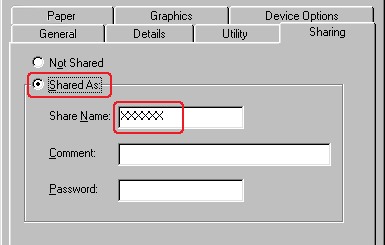
 |  |
Note:
|
 |  | -
Do not use spaces or hyphens for the share name, or an error may occur.
|
|
 |  | -
When sharing the printer, be sure to set EPSON Status Monitor 3 so that the shared printer can be monitored on the printer server. See Setting up EPSON Status Monitor 3.
|
|
You need to set the client computers so that they can use the printer on a network. See the following pages for details.
With Windows Vista, XP, 2000, or Windows NT 4.0
When the printer server's OS is Windows Vista, XP, 2000, or Windows NT 4.0, follow these steps to set the printer server.
 |
Note:
|
 | |
You must access Windows Vista, XP, 2000, or Windows NT 4.0 as the Administrators of the local machine.
|
|
 |
For a Windows 2000 or Windows NT 4.0 printer server, click Start, point to Settings, and click Printers.
For a Windows XP Professional printer server, click Start, and click Printers and Faxes.
For Windows XP Home Edition printer server, click Start, click Control panel, then click Printers and Faxes.
For a Windows Vista printer server, click Start, click Control Panel, click Hardware and Sound, and then click Printers.
|
 |
Right-click your printer icon, and click Sharing in the menu that appears.
|
For Windows XP, if the following menu appears, click either Network Setup Wizard or If you understand the security risks but want to share printers without running the wizard, click here.
In either case, follow the on-screen instructions.
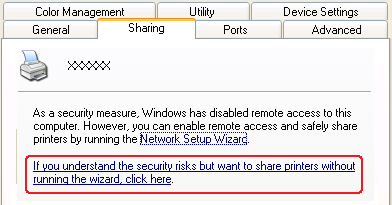
 |
For a Windows 2000 or Windows NT 4.0 printer server, select Shared as (for Windows 2000) or Shared (for Windows NT 4.0), then type the name in the Share name box and click OK.
|
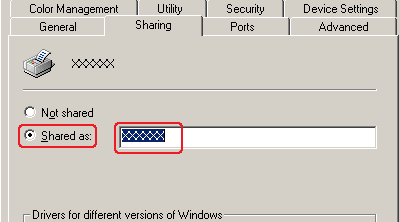
For a Windows Vista or XP printer server, select Share this printer, then type the name in the Share name box and click OK.
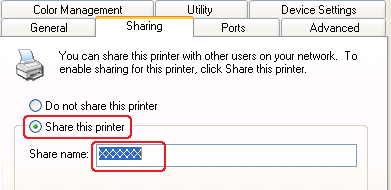
 |  |
Note:
|
 |  | -
Do not use spaces or hyphens for the share name, or an error may occur.
|
|
 |  | -
In Windows Vista, you cannot select share this printer until you click the Change sharing options button.
|
|
You need to set the client computers so that they can use the printer on a network. See the following pages for details:

[Top]
Setting for the clients
This section describes how to install the printer driver by accessing the shared printer on a network.
 |
Note:
|
 | -
This section describes how to access the shared printer on a standard network system using the server (Microsoft workgroup). If you cannot access the shared printer due to the network system, ask the administrator of the network for assistance.
|
|
 | -
This section describes how to install the printer driver by accessing the shared printer from the Printers folder. You can also access the shared printer from Network Neighborhood or My Network on the Windows desktop.
|
|
 | -
When you want to use the EPSON Status Monitor 3 at clients, you have to install both of the printer driver and the EPSON Status Monitor 3 in each client from the CD-ROM.
|
|
With Windows Me or 98
Follow these steps to set Windows Me or 98 clients.
 |
Click Start, point to Settings, and click Printers.
|
 |
Double-click the Add Printer icon, then click Next.
|
 |
Select Network printer, then click Next.
|
 |
Click Browse, and the Browse for Printer dialog box appears.
|
 |  |
Note:
|
 |  | |
You can also type "\\(the name of the computer that is locally connected to the shared printer)\(the shared printer's name)" in the Network path or queue name.
|
|
 |
Click the computer or server that is connected to the shared printer, and the name of the shared printer. Then click OK.
|
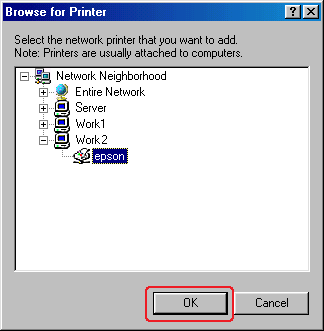
 |  |
Note:
|
 |  | |
The name of the shared printer may be changed by the computer or server that is connected to the shared printer. To make sure of the name of the shared printer, ask the administrator of the network.
|
|
 |
Click Next.
|
 |  |
Note:
|
 |  | -
If the printer driver is installed in the client beforehand, you need to select the new printer driver or the current printer driver. When the prompt to select the printer driver appears, select the printer driver according to the message.
|
|
 |  | -
If the printer server's OS is Windows Me or 98, go to the next step.
|
|
 |
Make sure of the name of the shared printer, and select whether to use the printer as the default printer or not. Click OK, and then follow the on-screen instructions.
|
 |  |
Note:
|
 |  | |
You can change the shared printer's name so that it appears only on the client computer.
|
|
With Windows XP or 2000
Follow these steps to set Windows XP or 2000 clients.
You can install the printer driver of the shared printer, if you have Power Users or more powerful access rights even if you are not the Administrator.
 |
For Windows 2000 clients, click Start, point to Settings, and click Printers.
For Windows XP Professional clients, click Start, and click Printers and Faxes.
For Windows XP Home Edition clients, click Start, click Control panel, then click Printers and Faxes.
|
 |
For Windows 2000, double-click the Add Printer icon, then click Next.
|
For Windows XP, click the Add a printer in the Printer Tasks menu.
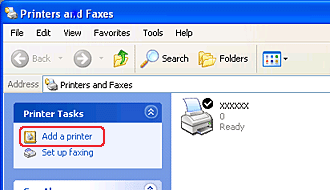
 |
Select Network printer (for Windows 2000) or A network printer, or a printer attached to another computer (for Windows XP), then click Next.
|
 |
For Windows 2000, select Type the printer name, or click Next to browse for a printer, then click Next.
|
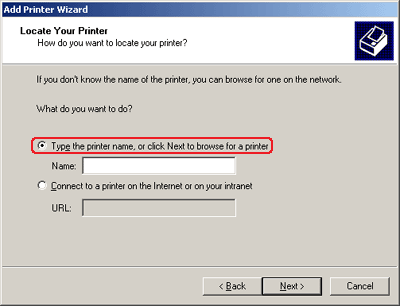
 |  |
Note:
|
 |  | |
You can also type the shared printer's name or network path in the Name box, such as "\\(the name of the computer that is locally connected to the shared printer)\(the shared printer's name)."
|
|
For Windows XP, select Browse for a printer, then click Next.
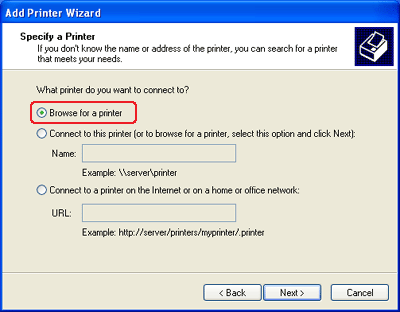
 |
Click the icon of the computer or server that is connected to the shared printer, and the name of the shared printer. Then click Next.
|
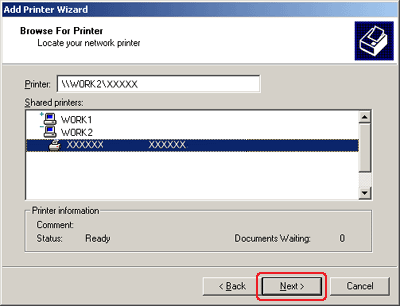
 |  |
Note:
|
 |  | -
The name of the shared printer may be changed by the computer or server that is connected to the shared printer. To make sure of the name of the shared printer, ask the administrator of the network.
|
|
 |  | -
If the printer driver is installed in the client beforehand, you need to select either the new printer driver or the current printer driver. When the prompt to select the printer driver appears, select the printer driver according to the message.
|
|
 |  | -
Proceed to the next step if the printer server and client have the same OS and the same architecture (x64/x86).
|
|
 |
For Windows 2000, select whether to use the printer as the default printer or not, then click OK.
|
For Windows Vista or XP, if another driver is already installed, select whether to use the printer as the default printer or not, then click OK.
 |
Make sure of the settings, then click Finish.
|
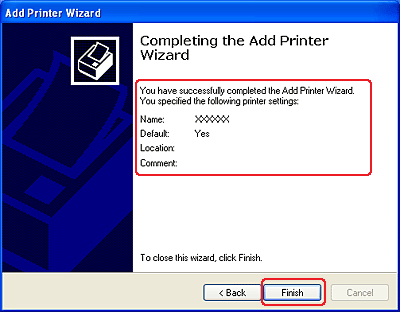
With Windows Vista
Follow these steps to set Windows Vista clients.
 |
Click Start, click Control Panel, click Hardware and Sound, and then click Printers.
|
 |
Click the Add a Printer icon.
|
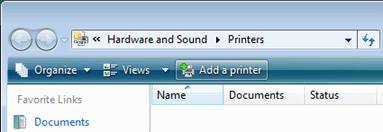
 |
Click Add a network, wireless or Bluetooth printer.
|
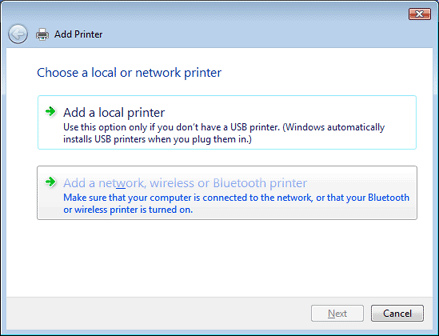
 |
A shared printer is automatically searched for.
|
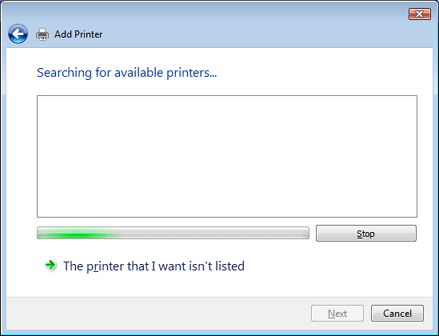
If a shared printer is found, click its icon and click Next.
If no shared printer is found, click the The printer that I want isn't listed button.
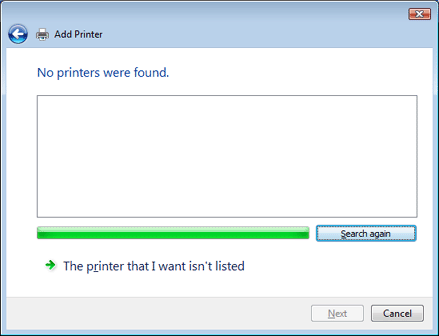
 |
Select Browse for a printer and click Next.
|
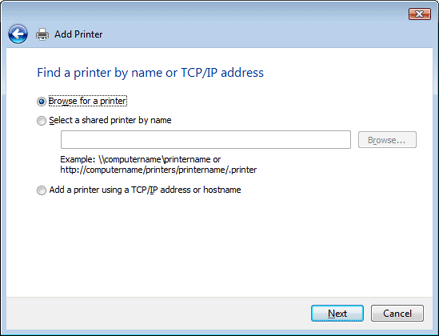
 |
A PC icon on your network appears.
|
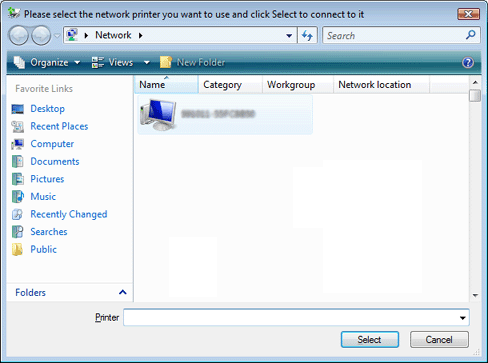
 |
Click the PC icon. A shared printer icon appears.
|
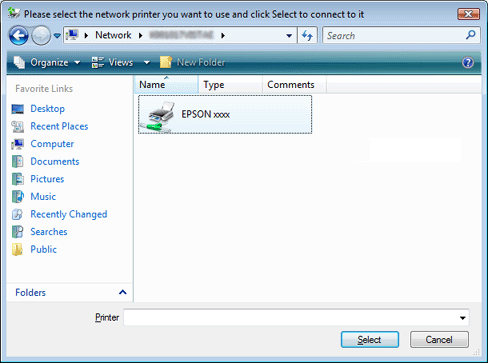
 |
Click Install driver.
|
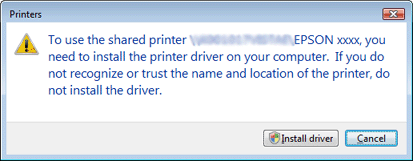
 |
Make sure that the appropriate printer driver name is shown, and click Next.
|
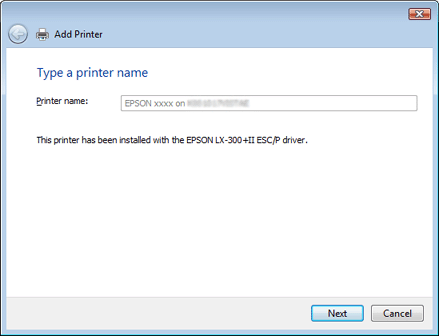
If any other printer driver has already been installed, the Set as the default printer checkbox will appear. If you want to set the shown printer as the default printer, select the checkbox and click Next.
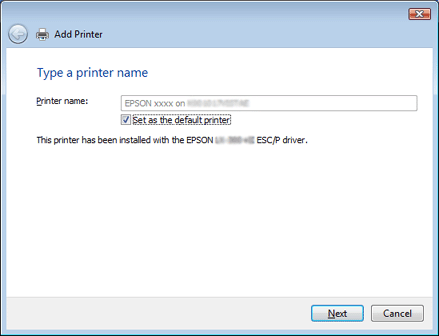
 |
Click Finish.
|
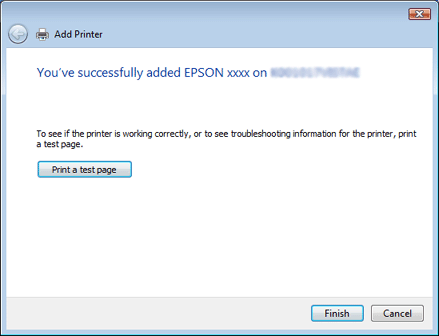
With Windows NT 4.0
Follow these steps to set Windows NT 4.0 clients.
You can install the printer driver of the shared printer, if you have Power Users or more powerful access rights even if you are not the Administrator.
 |
Click Start, point to Settings, and click Printers.
|
 |
Double-click the Add Printer icon.
|
 |
Select Network printer server, then click Next.
|
 |
Click the icon of the computer or server that is connected to the shared printer and the name of the shared printer. Then click OK.
|
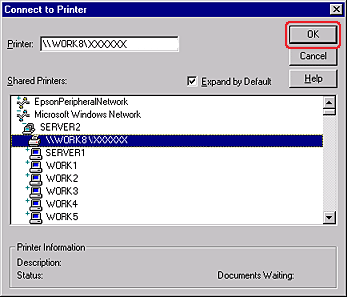
 |  |
Note:
|
 |  | -
You can also type "\\(the name of the computer that is locally connected to the shared printer)\(the shared printer's name)" in Network path or queue name.
|
|
 |  | -
The name of the shared printer may be changed by the computer or server that is connected to the shared printer. To make sure of the name of the shared printer, ask the administrator of the network.
|
|
 |  | -
If the printer driver is installed in the client beforehand, you need to select the new printer driver or the current printer driver. When the prompt to select the printer driver appears, select the printer driver according to the message.
|
|
 |  | -
If the printer server's OS is Windows NT 4.0, go to the next step.
|
|
 |
Select whether to use the printer as the default printer or not, then click OK.
|
 |
Click Finish.
|

[Top]
Installing the printer driver from the CD-ROM
This section describes how to install the printer driver in the clients when the computers of the server and clients use different OS.
The on-screen displays on the following pages may differ depending on the version of Windows OS.
 |
Note:
|
 | -
When installing in Windows Vista, XP, 2000, or Windows NT 4.0 clients, you must access Windows Vista, XP, 2000, or Windows NT 4.0 with the Administrator.
|
|
 | -
If the computers of the server and clients use the same OS and the same architecture, you do not have to install the printer drivers from the CD-ROM.
|
|
 |
Access the shared printer and a prompt may appear. Click OK, and then follow the on-screen instructions to install the printer driver from the CD-ROM.
|
 |
Insert the CD-ROM, then the EPSON Installation Program dialog box appears. Cancel the dialog box by clicking Cancel, then type the appropriate drive and folder names in which the printer driver for clients is located, then click OK.
|
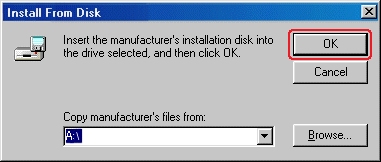
When installing drivers in Windows Vista, XP or 2000, "Digital Signature is not found." may appear. Click Yes (for Windows 2000) , Continue Anyway (for Windows XP) or Install this driver software anyway (for Windows Vista) and continue installing.
The folder name differs depending on the OS being used.
|
Client's OS
|
Folder Name
|
|
Windows 98
|
\<Language>\WIN98
|
|
Windows Me
|
\<Language>\WINME
|
|
Windows XP, 2000
|
\<Language>\WIN2000
|
|
Windows Vista x86 Edition
|
\<Language>\WINVISTA
|
|
Windows XP Professional x64 Edition, Vista x64 Edition
|
\<Language>\WINVISTA_XP64
|
|
Windows NT 4.0
|
\<Language>\WINNT40
|
 |
Select the name of the printer, then click OK. Then follow the on-screen instructions.
|
 |
Note:
|
 | -
If you want to use EPSON Status Monitor 3 for the shared printer, reinstall the printer driver as instructed in "Setting for the clients" after installing the printer driver and EPSON Status Monitor 3 from the CD-ROM. Before printing, be sure to select the printer driver installed in "Setting for the clients".
|
|
 | -
If EPSON Status Monitor 3 is installed with the Windows Firewall feature turned on (recommended), the shared printer may not be able to be monitored. If this occurs, follow the steps below to enable monitoring.
|
|

[Top]
| Version BPS0003-00, Copyright © 2007, SEIKO EPSON CORPORATION |
Sharing the printer
Setting up your printer as a shared printer
Setting for the clients
Installing the printer driver from the CD-ROM